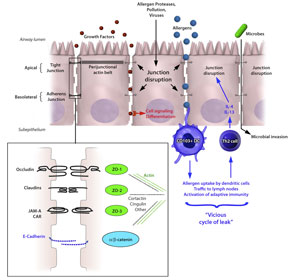
Cartoon diagram of airway epithelial cells
indicating junctional structures, including
TJs (black) and AJs (blue), which are intimately linked
with perijunctional actin filaments. (Enlarged image)
Recent research has positioned airway epithelial cells at the center of mucosal immune responses, because they sense and respond to inhaled allergens, particles and viruses and influence both innate and adaptive immunity. In addition to producing chemokines and cytokines that recruit and activate their target cells, epithelial cells form a physical barrier to the outside world. The epithelial barrier includes apical junctional complexes (AJC) consisting of tight and adherens junctions between neighboring cells.
Emerging evidence indicates that epithelial AJC dysfunction is associated with asthma, but mechanisms involved in this process are poorly understood. Furthermore, the relationship between epithelial barrier disruption, airway inflammation, and mucosal immunity has not been well–studied in vivo. We are currently using new assays of epithelial structure and function in both cell culture and mouse models. Our main goal is to uncover fundamental new pathways involved in these processes that can be exploited to improve the diagnosis and treatment of patients. Current projects in the lab are using genetic and pharmacologic approaches to study the role of protein kinase D in virus induced epithelial dysfunction, and determine how this relates to antigen uptake and processing by respiratory tract dendritic cell subsets.
Further Reading
Epithelial barrier function: at the front line of asthma immunology and allergic airway inflammation. Georas SN, Rezaee F. J Allergy Clin Immunol. 2014 Sep;134(3):509-20.